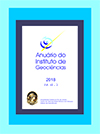Urban Phytophysiognomy Characterization Using NDVI from Satellites Images and Free Software
DOI:
https://doi.org/10.11137/2018_3_24_36Keywords:
Remote sensing, Urban modelling, Landsat 8, RapideyeAbstract
These paper reports applications using satellite images to the identification of vegetation types in the Campo Grande city. This identification allows studies of urban vegetation, palynology and environmental changes. Images from Landsat 8 and Rapideye satellites from the Campo Grande urban area were used. A soil coverage map was done for each one of the seven sub-regions. The Normalized Difference Vegetation Index was applied. In addition, a field survey was carried out to confirm the vegetation types sites through satellite images. Satellite images and in situ data validation allowed the distinction of the following features: water, urban structure, herbaceous, open and dense vegetation. For the identification of urban vegetation, Rapideye images were the most suitable for this type of study. The Rapideye satellite sensor detected 6.55% more dense vegetation area than Landsat 8 images.Downloads
Download data is not yet available.
Downloads
Published
2019-10-16
How to Cite
Gonçalves, A. B. (2019) “Urban Phytophysiognomy Characterization Using NDVI from Satellites Images and Free Software”, Anuário do Instituto de Geociências. Rio de Janeiro, BR, 41(3), pp. 24–36. doi: 10.11137/2018_3_24_36.
Issue
Section
Article
License
This journal is licensed under a Creative Commons — Attribution 4.0 International — CC BY 4.0, which permits use, distribution and reproduction in any medium, provided the original work is properly cited.















